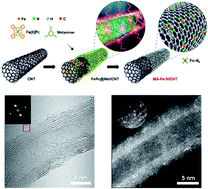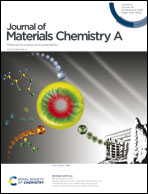Immobilizing single atom catalytic sites onto highly reduced carbon hosts: Fe–N4/CNT as a durable oxygen reduction catalyst for Na–air batteries†
Abstract
Immobilizing metal ions on a carbon support usually involves severe aggregation (sintering) and loose attachment of metal ions owing to a weak metal–support interaction. Here, we propose an alternative synthetic strategy termed ‘selective microwave annealing’ (SMA) to stabilize abundant single atom catalytic sites onto a highly reduced form of carbon host with only a few minutes of microwave irradiation. Thus, nitrogen-coordinated single atom iron sites on a carbon nanotube (Fe–N4/CNT) synthesized via SMA show unprecedented oxygen reduction reaction (ORR) activity and pH-universal durability superior to those of thermally annealed Fe–N4/CNT and expensive Pt/C catalysts. Furthermore, an aqueous Na–air battery with our Fe–N4/CNT catalyst operates as effectively as the device with the Pt/C catalyst. The method provides a new concept for the design of various strongly coupled and highly dispersed carbon-supported catalysts, which could open up new avenues for use in a wide range of electrochemical and catalytic applications.



 Please wait while we load your content...
Please wait while we load your content...